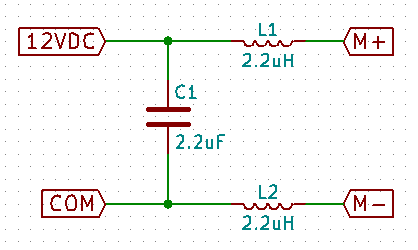This is an RFI filter from a 12V automotive DC motor. This motor design is over 20 years old and currently in "service" production. We just learned that the capacitor we're using is now in short supply and we need a replacement. Unfortunately, we can't find a comparable capacitor that also satisfies our mechanical dimension constraints.
We're starting to look at possibly using a smaller capacitor that will still satisfy our noise requirements. It's been a very long time since I've had to think about a filter. Can someone please give me a generic understanding of this filter? I know the capacitor is acting as a low-pass filter, but why the two inductors? If we were to replace the 2.2uF with a 1.0uF, what affect will it have (again, just looking for a relative understanding). I assume it will affect the cut-off frequency and/or attenuation?
- Can someone please give me a generic understanding of this filter?
- I know the capacitor is acting as a low-pass filter, but why the two inductors?
- If we were to replace the 2.2uF with a 1.0uF, what affect will it have (again, just looking for a relative understanding). I assume it will affect the cut-off frequency and/or attenuation?
Some additional info:
- Capacitor: 2.2uF, 63V, polyester film
- Inductors: 2.2uH, 10kHz, 15.5 turn
- Motor: 12VDC, brushed, 2 pole, 8 com

